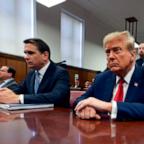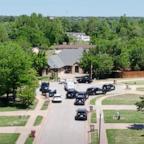Keeping cars on the ground at Daytona a tricky proposition
— -- DAYTONA BEACH, Fla. -- Matt Kenseth isn't too inclined to figure out why his car went airborne during the Sprint Cup race in May at Talladega Superspeedway.
He knows he got hit, his car started to spin and his car ended upside-down in the wall.
"I don't really spend any more or less time worrying about the restrictor-plate wrecks I have ever had," Kenseth said Thursday prior to practice at Daytona International Speedway. "That's been a part of [being here], at least since I started, for sure. I don't think that is ever going to go away as long as we race at Daytona and Talladega.
"You're all going basically the same speed and we're all going pretty fast and everybody is wide open. You can't get away from anybody. So when there's a wreck, there's a chance it's going to be a larger one."
NASCAR is working on trying not to have the large ones, especially the ones where the cars get airborne. Kenseth and Chris Buescher flipped in the last restrictor-plate race at Talladega, and Kevin Harvick's car had its wheels off the ground, all in separate accidents.
None of the drivers were hurt, which NASCAR will point to as a testament to its safety features. Austin Dillon also walked away from a nasty wreck a year ago at Daytona, although debris did hit fans with five requiring treatment at the track.
Kyle Busch, who broke his right leg and left foot in a hard wreck where he didn't get airborne at Daytona in 2015, felt frustrated that NASCAR didn't make any changes to the aero package after Talladega for the Coke Zero 400 on Saturday night at Daytona. "It is what it is," he said. "We'll go and crash some more."
NASCAR said it can't make a change without having a good idea of the consequences. If it wants to make a safety change, though, it can do so quickly.
NASCAR senior vice president Gene Stefanyshyn, the head car designer for NASCAR, said no car has gone airborne just from spinning out since the 2013 introduction of the Gen-6 car, where the roof flaps open earlier in a spin because they were extended further into the sides of the cars.
Kenseth's car had damage from being hit by Danica Patrick, and Dillon's car was launched by other cars as he spun across the track.
"Most of our incidents are tripping [such as Buescher getting knocked over] and ramping [such as Dillon] type of things," Stefanyshyn said. "Kenseth's was a damage-induced liftoff but we're still looking at it and we want to get our head around it. ... When the 10 [car of Patrick] bumped him in the right front, the wheel and the fender [were damaged], which created a bit of a wing."
NASCAR also concentrates on the offset of the right-side glass, which it views as a key to keep the cars from lifting off.
Kenseth said he appreciates NASCAR telling him what it has found about his wreck. With NASCAR having a drivers council and an owners council, he figures they have those conversations and has not felt as if he needs to pressure on NASCAR for answers.
"When something like that happens, everybody sees it," Kenseth said. "Obviously, NASCAR doesn't want the cars flying through the air. Obviously drivers don't want them flying through the air and they work as hard as they can to make it as safe as possible.
"I have all the confidence there is that they're always working on that stuff. They don't need me to make a call."
NASCAR did consider decreasing horsepower from the cars at Daytona, which already are sucked down to 450-500 horsepower at the restrictor-plate tracks -- to keep them from going so fast that they launch off the high-banked tracks.
"We have a list of items [to] design, develop and implement -- I'd love to be able to do things tomorrow but you need to do these in a very thoughtful way, a very thorough way and make sure no bad things happen, no unintended consequences," Stefanyshyn said. "That one, there is a couple of different opinions [on horsepower]."
And that has traditionally been the challenge. Ryan Newman said drop the horsepower and cars will turn over less. Other drivers have indicated slowing cars would just bunch them up even more (if that's possible).
"This has been going on for decades," said former driver Jeff Burton, an NBC analyst who has been one of the most outspoken drivers on safety. "It's a difficult situation. If you make the car go too fast, people think [to] take the restrictor plates off of them and then you're going really fast and something happens and it's worse.
"You put smaller plates on them and they go slower, then they're all in a big pack and they wreck and take a lot of cars with them. So it's a difficult solution. I know everybody has an opinion. You sit 20 drivers down, you get 20 different opinions."
The roof flaps appear to have worked in several spins to keep the cars on the ground.
"NASCAR has adjusted quarter-panel lengths time and time again, skirt height time and time again," said former Jeff Gordon and Dale Earnhardt Jr. crew chief Steve Letarte, also an NBC analyst. "Some of the issues that complicate the matter is it's one thing to have a car fly by itself singularly when a car gets backwards into the air. I think we've reduced that tremendously in this sport with the safety innovations.
"But when you go back to the accident in the closing laps of the Coke Zero 400 last year, what you saw with Austin Dillon's car, really it didn't fly, but it was pushed into the air by another car. I'm not sure aerodynamically there are any solutions for that, because I'm not sure how you could recreate that in the hundreds if not thousands of different ways that accidents could happen."
Drivers seem resigned to that fact. They have seen their cars get airborne at other tracks but not with the regularity as they have at restrictor-plate tracks.
NASCAR has added an overtime line to the backstretch to limit the number of crashes that could happen as the result of the attempted two-lap green-flag dash to the finish when the caution comes out late in the race. While NASCAR wants to have a green-flag finish, it won't restart the race if drivers have passed that overtime line on the first lap of a green-white-checkered finish. Before this year, it wouldn't restart the race if the drivers completed a full lap of the two-lap dash.
"I'm hopeful that NASCAR is looking at ways to figure out how to keep the cars on the ground," said Dale Earnhardt Jr. "We didn't make any changes going into this race from the package. But, they're two different race tracks, and hopefully that will play a role in keeping things a little safer for the drivers.
"But we've seen them flip everywhere, and it's just not at the plate tracks. We definitely didn't like what we saw at Talladega. And I'd rather not get upside down if I don't have to."




